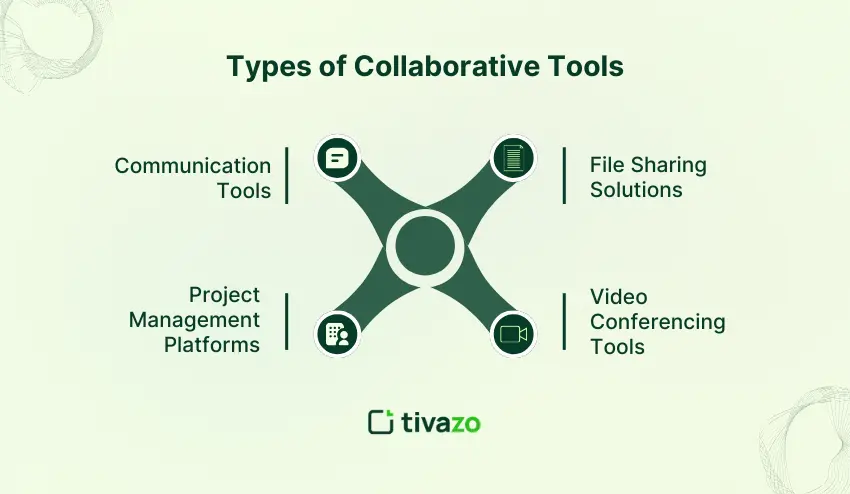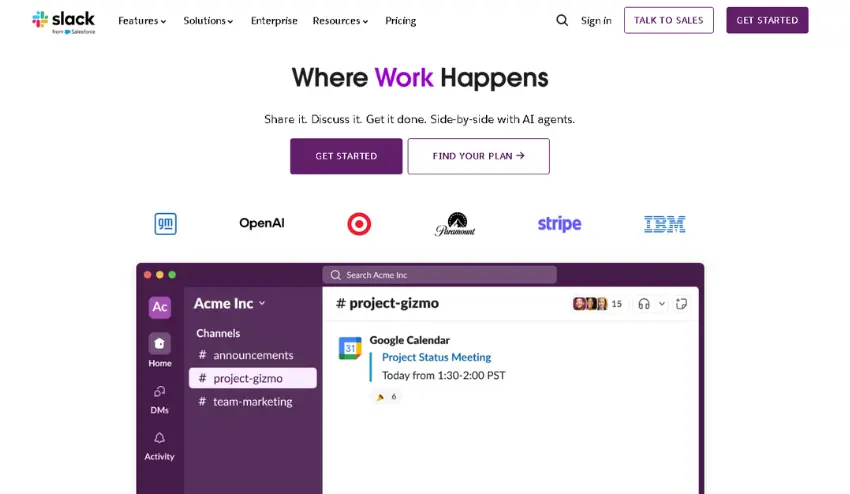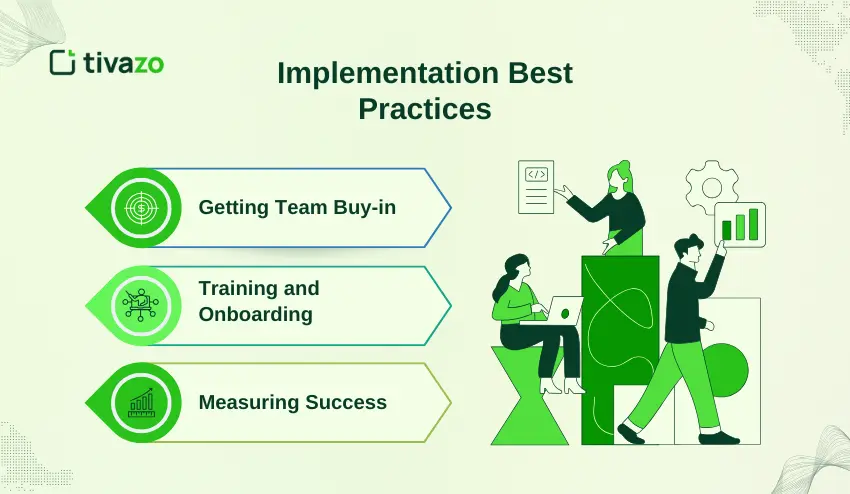Remote work is here to stay. As more than 42 percent of the American labor force now works remotely at least part-time, teams must find improved methods to remain connected and productive. The challenge? Getting everyone on track when they are all dispersed in various time zones, home offices, and coffee shops.
That is where collaborative tools come into play. These online applications are now the foundation of team collaboration. They assist remote teams to communicate effectively, project management, and file sharing.
Here, you will find the optimal collaborative tools in 2025. We will discuss all the team chat applications up to project management tools. Also, you will receive practical recommendations on how and what to use in your team.
What Are Collaborative Tools?
Collaborative tools refer to electronic platforms that help teams to coordinate their work, irrespective of their location. These software systems integrate communication, project management and file sharing features into integrated workspaces.
Consider them as the online headquarters of your team. Rather than having to deal with several emails, phone calls, and documents that are spread out, all that is done is under a single roof. The team members are able to communicate live, update on the project status, exchange files and have video meetings.
The objective is straightforward: to remove the barriers of communication and to maintain all on the same page. These collaborative tools will make it feel like you are collaborating remotely, whether you are running a small startup or organizing a team of people in a large enterprise.
Why Collaborative Tools Matter for Remote Teams
Remote teams have special challenges that are not experienced by in-office teams. Projects can be derailed because of communication gaps. Significant news is lost in the email chains. Employees are lonely and not united to the company culture.
Research indicates that productivity of teams that utilise collaborative tools increases by 25 percent and project completion rates are 30 percent accelerated. Work flows become smoother when everybody is informed with the same information and communication channel.
Here’s what collaborative tools deliver:
- Real time communication in different time zones without email delays.
- See the project in real-time so everybody can see what is going on.
- File storage that eliminates version control nightmares.
- Close interaction and transparency in the team.
The bottom line? Well-working teams achieve higher results within a shorter time. In the current competitive market that is more than an advantage.
Types of Collaborative Tools
Collaborative tools are not all the same. Various ones are used in the workflow of your team. Knowing these types can enable you to create a full set of collaboration tools.

1. Communication Tools
These websites manage the day-to-day discussions of your team. Consider instant messaging, discussions in groups and threaded discussions. Slack, Microsoft Teams, and Discord are some of the most popular business alternatives.
Communication tools substitute the email chains that are scattered with structured conversations. The team members will be able to open communication channels in certain projects, exchange brief messages and receive instant feedback.
2. Project Management Platforms
Project management tools assist teams to plan, track and deliver work on time. They offer assignment of tasks, tracking of deadlines and visualization of progress. The most popular ones are Asana, Monday.com, and ClickUp.
These tools provide a response to the question: who is doing what by when. at any given moment. Managers can see loads of teams and team members see their priorities.
3. File Sharing Solutions
The file sharing sites make sure that all people are in possession of the most current documents and resources. They deal with version control, permission control, and cross-device synchronization. This is dominated by Google Drive, Dropbox and OneDrive.
There is no longer a need to send files back and forth via email and to ask oneself which version is up to date. All people are working on the same basis of truth.
4. Video Conferencing Tools
Video conferencing introduces face to face communication to remote teams. These platforms facilitate meetings, webinars and screen sharing. The leaders of the market are Zoom, Microsoft Teams, and Google Meet.
Video conferencing keeps humans connected in remote work. They are necessary in complicated discussions, team building, and presentations.
7 Best Collaborative Tools for Teams
It is time to explore the best collaborative tools that can change the way your team works. All tools are good at other things and therefore when making a choice, you must consider your needs.
Slack – Team Communication

Slack transformed the communication system in the workplace by structuring the conversations into channels. Rather than the disorganized group emails, teams develop dedicated areas of discussion of various topics, projects, or departments.
Key Features:
- Structured discussions of various subjects and initiatives.
- One-on-one and discussion messages.
- Drag and drop simplicity in file sharing.
- 2,000+ app integrations such as Google Drive and Zoom.
Best for: 10-100 person teams that require formal communication. Works well especially with technological firms, marketing agencies, and remote workforces.
Pricing: Free small team plan. Premium plans begin at 7.25 per user monthly.
The advantage of Slack is that it allows maintaining conversations in order and making them searchable. Team members are able to locate past discussions and shared files quickly.
Monday.com – Project Management
Monday.com turns the spreadsheet mess into intuitive and visual project management. Individuals can manage projects, allocate tasks, and track progress using customizable boards and timelines.
Key Features:
- Board visuals with workflow customization.
- Assignments of tasks and reminders of deadlines are automated.
- Workload and time management.
- Built-in connections with 40+ most popular business applications.
Best for: Marketing groups, creative agencies, and project managers need to manage various projects running simultaneously. Gets along with groups of 5-50 individuals.
Pricing: The basic plan begins with a price of $8 per user per month. Free trial available.
Monday.com teams have been found to complete projects 25 times faster with greater visibility and coordination (user survey).
Google Workspace – Document Collaboration
Google Workspace (previously known as G Suite) allows real-time collaboration of documents. Several group members may work on the same document at the same time, comment and keep track of the changes automatically.
Key Features:
- Collaborative editing in real-time in Docs, Sheets and Slides.
- Cloud storage 15GB per user (with paid plans)
- Intelligent sharing policies and authorization.
- Fluid integration of all Google applications.
Best for: Any team that produces and shares documents on a regular basis. Consultants, education organizations, and in particular content teams find this particularly valuable.
Pricing: Free to use personally. The business plans begin at $6 per user per month.
The fact that you can see the cursors and edits of teammates in real-time remove the back and forth of document reviews. Teams will be able to work on proposals, reports and presentations without headaches of version control.
Zoom – Video Conferencing
The remote work boom made Zoom the household name of video conferencing. It provides stable, quality video calls to any size of team.
Key Features:
- HD video and sound quality with little lag.
- Virtual backgrounds and screen sharing.
- Meeting playback recording facilities.
- Small group discussion breakout rooms.
Best for: Any team that requires physical contact. Critical to meeting clients, team building and complex discussions that need visual communication.
Pricing: The Free plan permits 40 minutes of group calls. Pro plan begins with $14.99 monthly per license.
The reliability of Zoom during peak times is differentiating. Other platforms have difficulties with massive user loads, whereas Zoom does not.
Miro – Visual Collaboration
Miro offers an unlimited digital whiteboard on which teams can brainstorm, process-map, and work together visually. It is the equivalent of a white board in a conference room that is accessible to everybody anywhere.
Key Features:
- Brainstorming and mind mapping infinity.
- 300+ ready-made templates of standard workflows.
- Can do live cooperation with live cursors
- Slack and Jira integration and other workflow tools.
Best for: Visual thinkers: design teams, product managers, and strategy consultants. Ideal in workshops, sprint planning and creative sessions.
Pricing: Free with up to 3 boards. Team plan begins at $8 per user per month.
Miro is a master of the materialization of abstract ideas. Collaborative diagrams allow teams to visualize user journeys, map processes, and converge on complex ideas together.
Asana – Task Management
Asana assists teams to plan daily work to strategic projects. It gives strong automation capabilities and different views of projects that minimize manual efforts.
Key Features:
- Several project views (list, board, timeline, calendar).
- Custom fields and project templates.
- Task dependencies and automation of workflows.
- Complex reporting and goal monitoring.
Best for: Operations teams, product managers and any team dealing with complex workflows. Grows effectively in small team sizes to large organizations.
Pricing: Free with teams of up to 15 members. Premium packages begin with 10.99/user/month.
The automation capabilities of Asana enable teams to get rid of repetitive work. Once one has finished a task, the system can automatically give the next one to another member of the team.
Dropbox – File Sharing
Cloud file storage Dropbox was the first to offer cloud file storage and remains the leader with powerful sharing capabilities and trustworthy cross-platform sync. It makes sure that the latest files are available to the teams at all times.
Key Features:
- Free storage of 2GB (paid plans have much more)
- The synchronization of files between devices is automatic.
- Expiration-based advanced sharing controls.
- Version history to undo the old versions of the files.
Best for: Creative teams, consultants, and anybody dealing with large files. Especially useful in video, design and marketing material.
Pricing: 2GB storage, free plan. Plus plan begins at $10 per user per month.
The advantage of Dropbox is its ability to store large files that cannot be sent through email. Designers can exchange high-resolution images, video teams can work on the footage, and all of them are in touch.
How to Choose the Right Collaborative Tools
The right collaborative tools can be chosen only with the close understanding of the needs of your team. The misplaced decision may bring more troubles than it is trying to solve. These are the steps to making smart decisions.
1. Assess Your Team’s Needs
Begin by determining your greatest collaboration problems. Are the team members experiencing communication problems? Do projects lack visibility? Are the files spread across platforms?
Ask your team what is hurting them. Enquire about their communication preferences, level of technical comfortability and work routines. You use this information to select your tools.
Take into account the size of your team and expansion. What was effective on five people may not be effective on fifty. Find solutions that will expand with your organization.
2. Consider Integration Requirements
Integration capabilities are very important in modern teams because they make use of various tools. The collaborative tools that you are using must be interconnected with other systems that you have such as your CRM, accounting software and marketing systems.
See what integrations are possible and how simple they are to install. Others have hundreds of integrations but need technical skills to be implemented. Others are easier to connect and have plug and play connections.
Some integrations that are usually prioritized are email, calendar, file storage and your most used business applications. In case a tool is not able to connect with your key systems, look at alternatives.
3. Evaluate Budget and Scalability
The per-user pricing model is frequently used with collaborative tools, and it can become expensive fast. The total cost is to be calculated taking into consideration all the team members and not only the existing number. Include your growth estimates in the coming years 1-2.
See past the base subscription rate. Take into consideration setup costs, training time and possible loss of productivity during the transition period. In some cases a more costly tool will pay back in improved efficiency.
There are a lot of collaborative tools that have free trials or freemium. Use them to experiment with your real team, and then get a paid plan.
Implementation Best Practices
Selecting the excellent collaborative tools is not the whole battle. Implementation needs planning, communication and support to be successful. This is the way to make sure your team embraces new collaborative tools.

1. Getting Team Buy-in
Resistance to change is a normal occurrence, particularly when the team members have been used to working in a certain manner. Begin by clearly explaining the problems that these collaborative tools will address and the benefits that they will offer.
Engage team members in the process of selection. When individuals are involved in the selection of the tools, they become more interested in ensuring that they are made to work. Test pilot programs on a volunteer basis and then implement on a large scale.
Address concerns directly. In case a person is concerned with the new software, provide training and assistance. In case they are worried about the productivity of the transition, establish achievable expectations and schedules.
2. Training and Onboarding
Do not expect team members to discover new tools themselves. Offer formal training, including basic functionality and your application requirements.
Develop in-house workflow documentation. General tutorials are good, but tailored instructions of how your team will use each tool are priceless.
Assign power users, who may assist teammates with queries. Internal experts help in eliminating frustration and speed up adoption within the team.
3. Measuring Success
Establish success measures prior to the introduction of new tools. The usual metrics are response times, project completion rates and team satisfaction scores.
Follow usage trends to determine adoption issues. When some of the team members are not using new tools, ask why and offer extra assistance.
Gather feedback on a regular basis and adjust accordingly. The collaborative tools must change as your team needs them to, rather than compelling the team to adapt to strict systems.
Common Mistakes to Avoid
Even the best-intentioned teams fail to use collaborative tools without errors. It is possible to save time, money, and frustration by learning through the experience of others.
- Overload of Tools: The problem of overload of tools occurs when using more collaborative tools than necessary. Keep to key categories and do not have unnecessary solutions. When there are two tools that are similar in their usage, then select one and stick to it.
- Lack of Planning Integration: When there is no consideration of the integration of tools, this leads to information silos. Sketch out how the new tools will interface with the current systems and processes before integrating them into the system.
- Poor Training: When the assumption is that team members will learn tools on their own, they will underutilize and resist it. Proper training should be invested in at the beginning of the investment to maximize it.
- Disregard of Security: Collaborative tools deal with sensitive business data. Check security options, access controls, and data protection policies prior to committing. Take into account the compliance rules in your industry.
The trick is to begin with a small step and build up. Learn to use one category of collaborative tools and then add the other. This will establish trust and make sure that every tool is a value addition.
Conclusion
Collaborative tools are no longer considered as nice-to-have conveniences but have become business imperatives. Teams who master such platforms achieve superior results within a shorter time and have a great connection even though they are physically apart. The trick is to select the tools that best fit the needs of your team and apply them in a considered manner. Begin with the basic ones: communication, project management, and file sharing.
Add special tools when your requirements change. It is important to remember that collaborative tools are merely enablers. The culture of communication and teamwork behaviors are more important than any particular platform in your team .Pay attention to the good practices that any tool can facilitate. Are you willing to enhance the cooperation of your team? Begin with the quick-start checklist above and step by step. In the future you will be grateful that you invested in the improved teamwork today.




